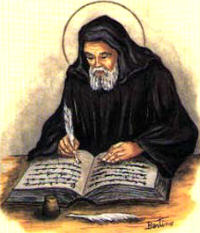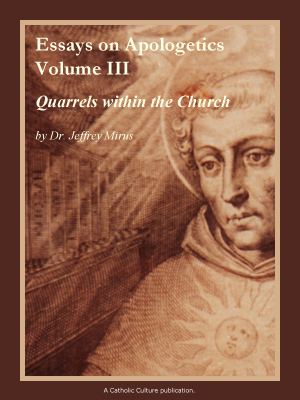Easter: May 25th
Optional Memorial of St. Bede the Venerable, priest and doctor; St. Gregory VII, pope; St. Mary Magdalene de Pazzi, virgin
Other Commemorations: St. Madeline Sophie Barat, Religious (RM)
» Enjoy our Liturgical Seasons series of e-books!
St. Bede was born in England. A Benedictine, he was "the most observant and the happiest of all monks." His writings were so full of sound doctrine that he was called "Venerable" while still alive. He wrote commentaries on Holy Scripture and treatises on theology and history. He died at Jarrow, England.
St. Gregory VII was a monk of Cluny. Before ascending to the papacy, he fought against the abuse of lay investiture, the source of the evils from which the Church was suffering. His energetic stance as Pope Gregory VII earned for him the enmity of the Emperor Henry IV. He was exiled to Salerno where he died.
St. Mary Magdalene de Pazzi was born in Florence and joined the Carmelites when she was nineteen. She practiced great mortification for the salvation of sinners; her constant exclamation was, 'To suffer, not to die!' With apostolic zeal, she urged the renewal of the entire ecclesiastical community.
Before the reform of the General Roman Calendar, today was the feast of St. Urban I, a Roman, successor of Callistus in the papal chair (222-230) and St. Madeline Sophie Barat, foundress in France of the Society of the Sacred Heart. Their feasts are no longer celebrated in the United States.
St. Bede the Venerable
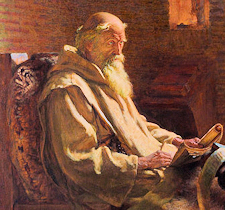 Bede occupies an important niche in Church history by bridging the gap between patristic and early medieval times, the era when the Germanic nations had just been Christianized. Through him Christian tradition and Roman culture came to the Middle Ages. He is also honored as the "father of English history." His writings were read publicly in churches while he was still alive; but since he could not be called "Saint," the title of Venerable was attached to his name, a usage which continued down through the centuries.
Bede occupies an important niche in Church history by bridging the gap between patristic and early medieval times, the era when the Germanic nations had just been Christianized. Through him Christian tradition and Roman culture came to the Middle Ages. He is also honored as the "father of English history." His writings were read publicly in churches while he was still alive; but since he could not be called "Saint," the title of Venerable was attached to his name, a usage which continued down through the centuries.
True Benedictine that he was, his life revolved around prayer and work. On the vigil of the Ascension he felt death approaching and asked to be fortified with the last sacraments. After reciting the Magnificat antiphon of the feast's second Vespers, he embraced his brethren, had himself placed upon a coarse penitential garment on the earth, and breathed forth his soul while saying softly: "Glory be to the Father, and to the Son, and to the Holy Ghost."
How St. Bede loved the Bible! Anyone who intends to live with the Church must keep the Scriptures near—day in, day out. St. Bede explained the Bible to others. At times you too will have this privilege. Use it.
—Excerpted from The Church's Year of Grace, Pius Parsch.
Patronage: Lectors; historians; Redemptoris Mater Seminary, Uzhhorod, Ukraine
Symbols and Representation: Pitcher of water and light from Heaven; scroll; pen and inkhorn; volume of ecclesiastical history.
Often portrayed as: Monk writing at a desk; old monk dying amidst his community; old monk with a book and pen; old monk with a jug.
Highlights and Things to Do:
- Learn more about monasticism and about the Benedictine Order.
- Watch this video of the life of St. Bede or this video.
- Read the Ecclesiastical History of the English People by St. Bede or listen to the Audiobook here
- Learn more about St. Bede:
- See Saints in Rome and Wikipedia for details about his relics.
St. Gregory VII
Gregory VII—his name had been Hildebrand before becoming Pope—was born about the year 1020. For two years he was a Benedictine monk of Cluny (1047-1049), then he became a cardinal, and finally, in 1073, Pope. A strong character with a remarkable personality, he easily takes a place with the greatest popes in the Church's history.
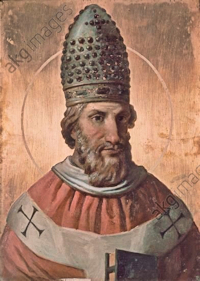 His life was one long struggle to purify and unify the Church, and to make her free and independent of secular powers. He enacted strict prohibitions against simony (the purchasing of ecclesiastical preferments), clerical concubinage, and lay investiture (appointment to ecclesiastical offices by civil authorities). On this later score he soon became involved in a dispute with the Emperor Henry IV which caused him untold trouble and which finally resulted in banishment and death. But his stand cleansed the Church and restored its status. Gregory died in exile with these words on his lips: "I loved justice and hated iniquity, therefore I die in exile."
His life was one long struggle to purify and unify the Church, and to make her free and independent of secular powers. He enacted strict prohibitions against simony (the purchasing of ecclesiastical preferments), clerical concubinage, and lay investiture (appointment to ecclesiastical offices by civil authorities). On this later score he soon became involved in a dispute with the Emperor Henry IV which caused him untold trouble and which finally resulted in banishment and death. But his stand cleansed the Church and restored its status. Gregory died in exile with these words on his lips: "I loved justice and hated iniquity, therefore I die in exile."
Concerning him the Protestant historian Gregorovius wrote: "In the history of the papacy, there will always be two shining stars to reveal the spiritual greatness of the popes. The one is Leo, before whom the terrible destroyer Attila drew back; the other is Gregory, before whom Henry IV knelt in the garb of a penitent. Each of these world renowned men, however, engenders a different reaction. Where Leo inspires highest reverence for pure moral greatness, Gregory fills one with admiration because of an almost superhuman personality. The monk who won without weapons has more right to be admired than Alexander, Caesar, or Napoleon.
"The battles fought by medieval popes were not waged with weapons of iron and lead, but with moral weapons. It was the application and operation of such lofty, spiritual means that occasionally raised the Middle Ages above our own. Alongside Gregory, Napoleon appears as a bloody barbarian. . . . Gregory's accomplishment is a distinctly medieval phenomenon, to study it will always be exciting. The history of the Christian world would lose one of its rarest pages if this stalwart character, this artisan's son in the tiara, were missing."
—Excerpted from The Church's Year of Grace, Pius Parsch.
Highlights and Things to do:
- As we recall this great pope, we should spend some time reading the writings of our current pope and thanking God for the gift of the papacy to the Church.
- Read more about St. Gregory:
- Read about Emperor Henry IV and the Internecine wars here.
- Watch this video about the conflict between Pope Gregory VII and Emperor Henry IV.
St. Mary Magdalene de Pazzi
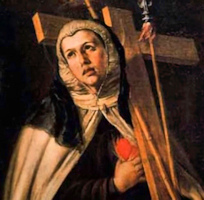 St. Mary Magdalene de'Pazzi was born in 1566 at Florence, Italy, as Catherine. she was a highly gifted mystic, had made a vow of chastity at the age of ten. She entered the convent of the Discalced Carmelite nuns in Florence, because the practice of receiving holy Communion almost daily was observed there. For five years her only food was bread and water. She practiced the most austere penances and for long periods endured complete spiritual aridity. Her favorite phrase was: "Suffer, not die!" Her body has remained incorrupt to the present day; it is preserved in a glass coffin in the church of the Carmelite nuns at Florence.
St. Mary Magdalene de'Pazzi was born in 1566 at Florence, Italy, as Catherine. she was a highly gifted mystic, had made a vow of chastity at the age of ten. She entered the convent of the Discalced Carmelite nuns in Florence, because the practice of receiving holy Communion almost daily was observed there. For five years her only food was bread and water. She practiced the most austere penances and for long periods endured complete spiritual aridity. Her favorite phrase was: "Suffer, not die!" Her body has remained incorrupt to the present day; it is preserved in a glass coffin in the church of the Carmelite nuns at Florence.
Purity of soul and love of Christ are the chief virtues which the Church admires in St. Mary Magdalen of Pazzi. These virtues matured her spiritually and enabled her to take as a motto, "Suffer, not die!" Purity and love are also the virtues which the Church today exhorts us to practice in imitation of the saint. We may never attain her high degree of holiness, but we can at least strive to suffer patiently out of love for Christ.
—Excerpted from The Church's Year of Grace, Pius Parsch.
Patronage: Bodily ills; sexual temptation; sick people.
Highlights and Things to Do:
- Contemplative nuns and monks spend their whole lives praying for the needs of the world and doing penance for the sins of others, but they also need our prayers. Say a prayer today for someone you know who is a contemplative religious or for a contemplative community which is in your area.
- Read more about St. Mary Magdalene de Pazzi:
- Read Who Was St. Mary Magdalene de Pazzi?
- Watch this video on St. Mary Magdalene de' Pazzi.
- See her statue on the St. Peter's Basilica Colonnade
St. Madeleine Sophie Barat
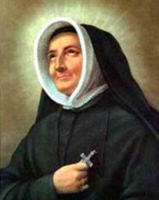 Under the guidance of her brother Madeleine Sophie Barat became at an early age proficient in Latin, Greek, Spanish and Italian. The brother, nine years her senior, was a stern disciplinarian. If her work was bad, she was punished—sometimes by a box on the ears—but if she did well, no word of praise was uttered. She was never allowed to relax from this discipline—even walks were forbidden unless they were strictly necessary for exercise; and when, in a moment of mistaken tenderness, she gave her brother a present, he threw it on the fire. She was ten when the French Revolution occurred in 1789. Afterwards, and still under the influence of her brother, she met Father Varin who desired to found a female counterpart of the Jesuits which should do for girls' education what they did for boys' education. On November 21, 1800, Madeleine with three companions dedicated herself to the Sacred Heart and so the New Congregation was begun. From the first house at Amiens it was to spread in the lifetime of its foundress all over Europe and to Africa and America, and its boarding schools have become famous.
Under the guidance of her brother Madeleine Sophie Barat became at an early age proficient in Latin, Greek, Spanish and Italian. The brother, nine years her senior, was a stern disciplinarian. If her work was bad, she was punished—sometimes by a box on the ears—but if she did well, no word of praise was uttered. She was never allowed to relax from this discipline—even walks were forbidden unless they were strictly necessary for exercise; and when, in a moment of mistaken tenderness, she gave her brother a present, he threw it on the fire. She was ten when the French Revolution occurred in 1789. Afterwards, and still under the influence of her brother, she met Father Varin who desired to found a female counterpart of the Jesuits which should do for girls' education what they did for boys' education. On November 21, 1800, Madeleine with three companions dedicated herself to the Sacred Heart and so the New Congregation was begun. From the first house at Amiens it was to spread in the lifetime of its foundress all over Europe and to Africa and America, and its boarding schools have become famous.
Madeleine's energy in extending the work was seconded by her reliance on God which enabled her to succeed in times of great difficulty. 'Too much work is a danger to an imperfect soul,' she said, 'but for one who loves our Lord it is an abundant harvest.'
—Excerpted from The Saints edited by John Coulson
Highlights and Things to Do:
- Read more about St. Madeleine Sophie Barat:
- Read In Paris Walking with Saint Madeleine-Sophie Barat. This pdf file gives St. Madeleine-Sophie's life and the history of the religious family she found as well as the history of Paris just after the French Revolution.
- See her Founder's Statue at St. Peter's Basilica.
- Her tomb is located in Paris, France at the Church of Saint François Xavier
- Watch this short video of St. Madeleine Sophie Barat.


